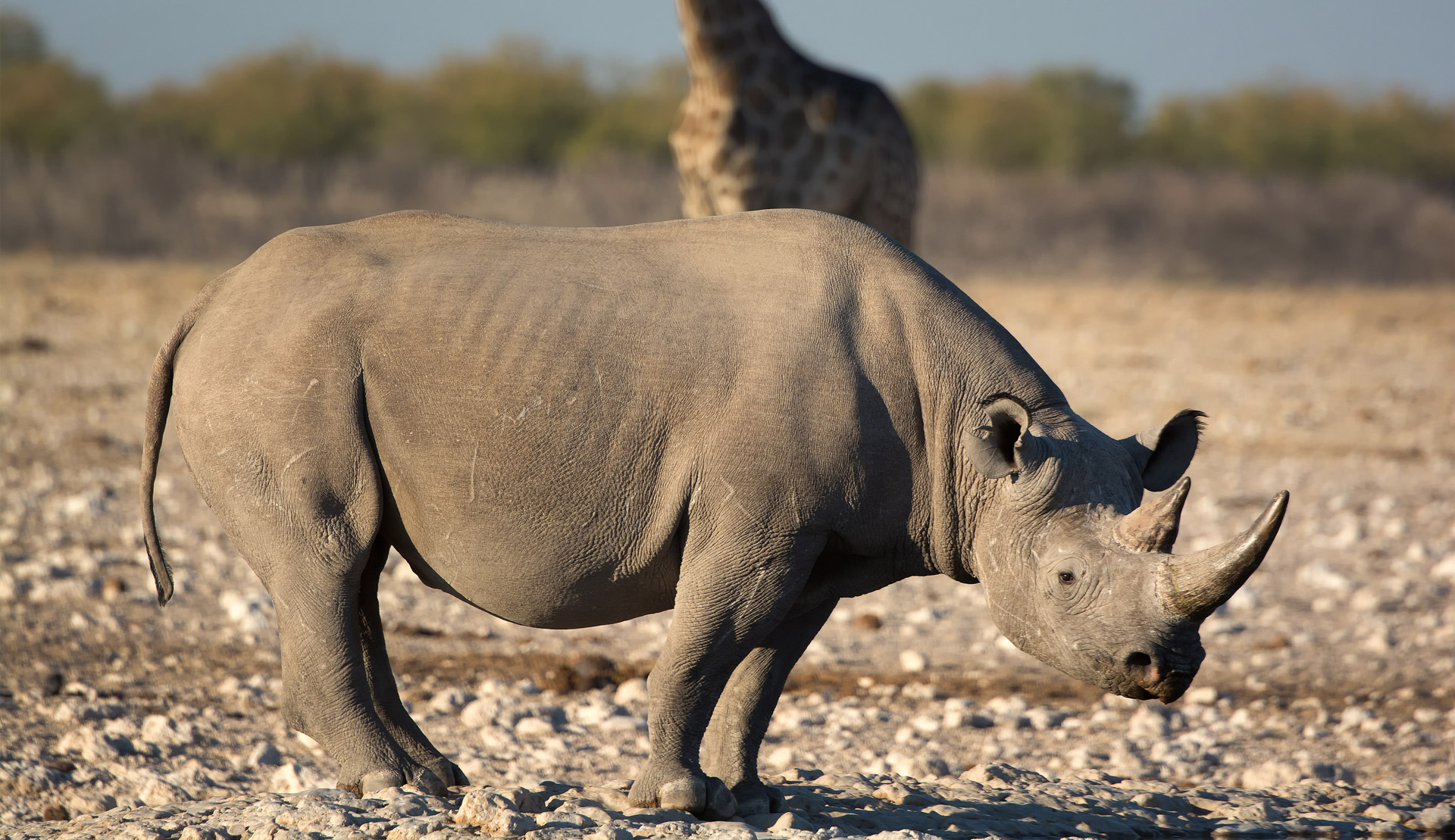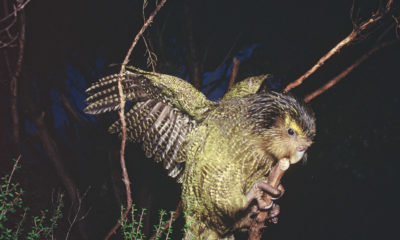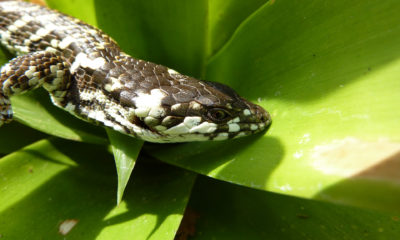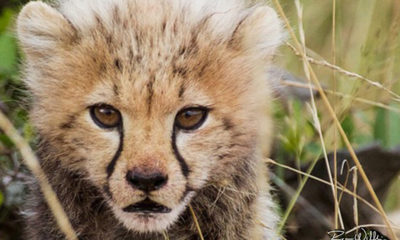It is this story that has become all too common for the species as it struggles to recover from dreadfully low numbers in the 1990s.
Species: Black Rhinoceros (Diceros bicornis) | Conservation Status: Critically Endangered | Region: Southern and South-eastern Africa | Interview: Philip Muruthi, Vice President for Species Conservation at African Wildlife Foundation (AWF) and Chief Scientist
by Paris Bates
- Some estimates put historical black rhinoceros numbers at 850,000. There are now under 5,000 remaining
- The biggest threat facing the species is poaching for their horns
- African Wildlife Foundation is working to protect the surviving individuals.
About The Black Rhinoceros
Encountering black rhinoceros (Diceros bicornis) in sub-Saharan Africa was once an easy feat; although solitary animals, it was not uncommon to sight upwards of 12 individuals in a single 24-hour period. It is estimated that at one time, there may have been upwards of 850,000 individuals. By the 1960s, there were around 100,000, and by 1995, the future of the species seemed bleak when a mere 2,410 remained. While numbers are increasing, with about 4880 individuals by the end of 2010, a high demand for rhino horn on the black market sees poaching remain the black rhino’s largest threat, and ensures their listing as critically endangered by the IUCN is to remain for some time to come.
The Details
Contrary to what the species’ common names may suggest, black rhinoceros and sister species white rhinoceros (Ceratotherium simum), are not discernible from one another due to their colour, as both are a pale shade of grey. The primary difference between the two comes from their lip; black rhinos have a prehensile lip adapted to plucking foliage, fruits and twigs with ease. It is this feature that sees them often being referred to as the ‘hook-lipped’ rhino. Contrasting this, white rhinos have a square lip ideal for grazing on the grass of the flat African plains. It is estimated that the two ungulate species diverged from one another between 4 and 5 million years ago.
There are currently three subspecies of black rhinoceros recognised by the IUCN after the western black rhinoceros (D. b. longipes) was declared extinct in 2011. The extant species are the south-western black rhinoceros (D. bicornis), eastern black rhinoceros (D. b. michaeli), and southern-central black rhinoceros (D. b. minor). While their former range has reduced since European settlement throughout African in the late 19th century, conservation efforts have seen the successful reintroduction of populations in Botswana, Malawi, Swaziland and Zambia.
The arrival of Europeans was the unfortunate beginning of their demise as they were hunted for food and, often, simply amusement. A further influx of Europeans arriving early in the 20th century saw the hunting continue: as agricultural developments and plantations were consumed by black rhino, frustrated settlers began considering them pests needing to be exterminated. It was in the 1960s that they became widely recognised as a source of wealth, and poaching in order to obtain the horn of the animals intensified. Rhino horn can fetch upwards of $350,000 on the black market, the hefty payout enticing trophy hunters and causing the dramatic decline of numbers seen between the 1960s and 1990s.
As population numbers diminished rapidly, a ban on rhino horn trade was introduced in 1977. Despite this ban, the decrease continued, and in 1983 sanctuaries for black rhinos were created. However, illegal poaching remains the largest threat for the mammals: their size, weighing upwards of 1000 kilograms, is unfortunately conspicuous in the burnt landscape of Africa.
Black Rhinoceros Conservation
Philip Muruthi, Vice President for Species Conservation at African Wildlife Foundation (AWF), doubles as the foundation’s Chief Scientist, leading on AWF’s species work. A large proportion of this work involves black rhino conservation across Africa.
“I assist in designing, planning and implementing AWF and our key partner activities to protect rhino in their natural habitats; our goal being to conserve viable and ecologically-functional populations of the species.”
The AWF’s approach to black rhino conservation is threat-based, as they anticipate and react to factors that prevent the species from thriving, “such as poaching, trafficking and demand for rhino horn,” explains Muruthi. He works in situ to protect rhino, “stopping the killing, trafficking and demand.”
One of Muruthi’s main roles is assisting field teams, ensuring they have necessary and sufficient resources in order to protect the species and their habitats.
“Ordinarily this involves finding and disbursing resources for direct anti-poaching efforts – equipment, tents, training and monitoring of the target populations,” says Muruthi.
“I am very keen on knowing that the rhino themselves are present and safe hence I work with field teams to record, collate and analyse population data to decipher trends in numbers and age/sex classification.”
In addition to consistent and continuous contact with those in the field, a relationship with government authority is maintained in order to ensure the infrastructure of sanctuaries are kept in perfect working condition. This includes components such as fencing, water supply, road networks, offices, ranger houses and camps.
One of the main sanctuaries with close associations to AWF is the Ngulia Rhino Sanctuary in Tsavo East National Park, Kenya. AWF’s involvement in this sanctuary began early in the 1980’s, and over this time the rhino population has grown more than ten times.
“(We) support anti-poaching, park infrastructure, species monitoring, community engagement – all needed for a successful conservation program,” notes Muruthi, who has been a member of Kenya’s national rhino management committee for more than ten years.
Partnering for Success
The partner efforts between AWF and Tsavo have been particularly effective. The evidence for this comes from how well the rhinos, elephant and other species’ populations have done, as observed by Muruthi and others involved in the sanctuary. Despite this, challenges persist, demanding determined efforts.
The largest threat to the black rhino, amongst other endangered African species, is poaching. Muruthi says: “we are in a poaching crisis continent-wide”.
With anti-poaching laws proving to be unsuccessful, success is heavily dependent on active field conservation and sanctuary work, as well as engagement from the public, which he explains can occur on several levels.
“(This includes) contributing resources/finances, being good ambassadors for the conservation message, directly protecting the habitats, reporting suspicious cases at site levels, and not getting involved in trafficking and demand for rhino horn.”
It is not entirely effective as challenges change and the foundation and its staff have to keep adapting strategically. It is also not the only threat rhino face.
“In some cases,” Muruthi continues, “habitat quality and availability are challenges related to the fact that rhino are heavily protected and some suitable areas are excluded by insecurity at the moment.”
Black rhino are entirely conservation dependent, which makes determining their future difficult, particularly at this time when poaching and trafficking continues to increase. Muruthi maintains that the changing nature of these crimes, including spreading and intensity, requires all those involved in rhino conservation to remain vigilant.
“Only with concerted efforts will the populations of black rhino – indeed all rhino – continue to grow. Growth is much needed for all rhino populations as they have suffered much decline recently and historically.”
The dedication and passion evident from Muruthi and the team provides much-needed hope for future.
“Rhino are resilient animals and will [certainly] survive beyond this current crisis as they did the one before it. All humans owe the rhino its continued survival,” says Muruthi, before commenting: “Our own survival is linked to healthy ecosystems that rhinos are a part of and help to maintain.”
Captions and credits for images, from top-down:
All photos courtesy of African Wildlife Foundation. All rights reserved.
References:
– Antoine, P.O., Orliac, M.J., Atici, G., Ulusoy, I., Sen. E., Cubukcu, H.E., Albayrak, E., Oyal, N., Aydar, E., Sen, S. (2012) A Rhinocerotid Skull Cooked-to-Death in a 9.2 Ma-Old Ignimbrite Flow of Turkey, PLOS one
– Greaver, C., Ferreira, S., Slotow, R. (2014) Density-dependent regulation of the critically endangered black rhinoceros population in Ithala Game Reserve, South Africa, Austral Ecology 4: 437-447
– Williams, N., Milledge, S., Adcock, K., Brooks, M. (2005) Trophy Hunting of Black Rhino Diceros Bicornis: Proposals to Ensure Its Future Sustainability, Journal of International Wildlife Law and Policy 8: 1-12
– The IUCN Red List for Endangered Species (2012) Diceros bicornis, accessed 16 November 2016, http://www.iucnredlist.org/details/6557/0























You must be logged in to post a comment Login